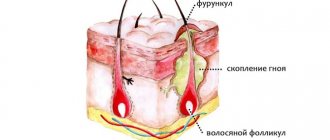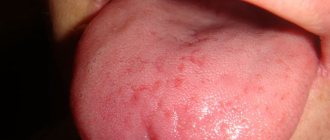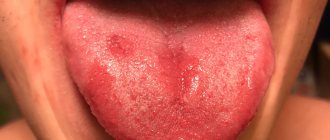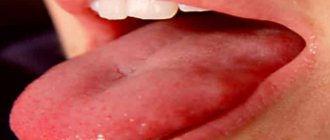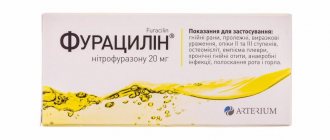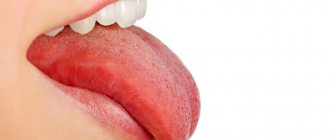The presence of a pip on the tongue indicates the development of a pathology of infectious etiology, requiring immediate treatment.
The material in this article consists of basic concepts, classification, causes, symptoms, diagnosis, methods of therapy and prevention of this pathology. This article also describes the features of treatment of glossitis in children and during pregnancy.
What kind of disease is this?
In medical terminology, a tip on the tongue is called glossitis. This is an inflammation of the soft tissues of the tongue of infectious and non-infectious origin, which develops as a result of the presence of bacterial or viral microflora in the oral cavity.
A characteristic difference of this pathology is a change in its structure and color, both on the surface and in the deep layers of the organ.
Important ! Pipun are inflamed papillae of the tongue that look like small ulcers or pimples that may contain fluid inside. If they appear, you should immediately seek medical help. This will eliminate the development of a chronic form of pathology, which subsequently cannot be treated.
Pipun does not belong to the category of independent diseases. Most often, glossitis is a manifestation of certain pathologies associated with the development of inflammatory processes.
Therefore, it is impossible to accurately determine whether tongue glossitis is contagious. If the etiology of the disease is non-infectious, then there is no point in talking about the transmission of pathology.
Pipun are inflamed papillae of the tongue that look like small ulcers or pimples that may contain fluid inside.
Poisoning
Poisoning in birds ends in mortality, either within a few hours or within a few days. The cause of poisoning can be poisonous plants that come across in the hay or while the bird is grazing, as well as seeds of poisonous plants, food susceptible to putrefactive bacteria, mold, as well as pesticides and fertilizers.
Common symptoms are cramps, diarrhea, vomiting, thirst, and sudden death.
- Poisoning can occur due to poor disinfection, namely slaked lime or caustic soda. Symptoms of poisoning include swelling of the head and inflammation or swelling of the eyelids. In such cases, the bird is given vinegar diluted in three times the amount of water, and the eyes are washed with warm water.
- If forage grasses have been stored without proper technology, nitrile glycosides accumulate in them and strong acid is released. The bird experiences drooling, rapid breathing, convulsions, and suffocation.
- After consuming a large amount of salt, or poorly mixed salt in the mash, salt poisoning occurs in the bird. Death occurs within 10–12 hours. Timely rescue of the bird will yield results, for example, pouring cold water on the bird, and if this does not help, then give mucous decoctions, vegetable oil and vodka (10 g per head).
- Red beets are the most dangerous; you should not feed the bird rotten beetroots.
- Potato poisoning often occurs in the spring, when solanine accumulates in the tubers. Potatoes that have turned green and wilted are not recommended for feeding to poultry. In case of poisoning, they give a mucous decoction, as well as charcoal from burnt bones (3 g per head).
- Non-contagious diseases in poultry arise as a result of errors in feeding, and, of course, in violation of the maintenance regime - when using dirty water and low-quality feed.
Causes of pip on the tongue
The etiology of the development of glossitis is very diverse. First of all, it is associated with the growth of various pathogens in the oral cavity, which, after damage to the tongue, penetrate into the wounds and provoke the development of the inflammatory process.
Against the background of a weakened immune system, a pip appears on the affected area.
Why and what causes the pip on the tongue?
The most popular causes of pip include:
- Against the background of a weakened immune system, a pip appears on the affected area
Violation of the integrity of the epithelium of the tongue.
- Dysfunctions of the human immune system.
- Vitamin deficiency, primarily B vitamins, retinol and ascorbic acid.
- Thermal or chemical injury to the tongue.
- Piercing.
- Dental pathologies: abnormal bite, stomatitis, wearing braces, improper installation of implants, acute periodontitis.
- The presence of bad habits: smoking, drug and alcohol abuse, onychophagia, addiction to highly seasoned and highly saturated foods.
- Individual intolerance to the components of oral care products.
Also, pip can be a characteristic sign of more dangerous pathologies: diphtheria, stomatitis, tuberculosis, helminth infestation, anemia, measles, diseases of the gastrointestinal tract. Often its appearance is observed in women during pregnancy.
Important! Correct determination of the etiology of glossitis will allow the disease to be cured in the shortest possible time, eliminating the main cause of its development.
Pasteurrelosis disease (cholera)
This is also an infectious disease. Mainly characterized by severe nasal discharge and high mortality. The source of infection includes sick or ill birds, insects, rodents, and contaminated food. And the main thing is that the virus is transmitted through contact.
When the disease occurs in an acute form, the bird is depressed, eats poorly, has a characteristically pronounced nasal discharge, wheezing, difficulty breathing, diarrhea, which leads to the bird’s death as general weakness increases within 18–72 hours.
The virus is bactericidal by a solution containing 3% formaldehyde and 3% sodium hydroxide, 10% iodine monochloride, as well as a clarified solution of bleach containing 5% active chlorine, and a 20% suspension of bleach.
For any illness, we advise you to consult a veterinarian.
Symptoms
The symptoms of glossitis are directly related to the degree of development of the pathology.
At the initial stage, the presence of pip is accompanied by the following external manifestations:
- In addition to the external manifestations of the pathology, discomfort, burning and pain are felt when eating or talking.
The surface of the tongue is covered with single or numerous pimples.
- The area around the tip is inflamed and red.
- Swelling is observed in the affected area of the muscular organ.
- Salivation increases.
- The surface of the tongue may become covered with a whitish coating.
In addition to the external manifestations of the pathology, discomfort, burning and pain are felt when eating or talking. The patient's sense of taste becomes dull or completely disappears.
The advanced stage of the disease is characterized by the following symptoms:
- Persistent and dense swelling of the tongue.
- Hyperplastic changes in the structure of the organ.
- The presence of mushroom-shaped growths.
- With a viral etiology of the pip, erosion subsequently forms in its place.
- A local increase in temperature is observed.
Important! When the first symptoms appear, treatment should be started immediately. The advanced stage of glossitis is complicated by abscesses, and when the pathology becomes more complicated, phlegmon of the soft tissues of the mouth and neck develops.
Kinds
The International Classification of Diseases defines the following types of glossitis:
- Wandering (desquamatous). The pathogenesis of the pathology is associated with focal destruction of the epithelium, forming red areas of a pronounced red color on the surface of the tongue and its sides.
- Atrophic. A characteristic feature is a reduction in the size of the tongue. The etiology of this form of the disease is associated with infection of the body of any etiology, as well as the development of oncology of the organ and its injury.
- Diamond-shaped. As it develops in the central part of the tongue, the papillae atrophy and visually form a small lesion. It has three forms: flat, tubercular, hyperplastic.
- Black tongue (villous tip). It manifests itself as the growth of papillae in the form of threads over the surface of the tongue, followed by their keratinization.
- Folded. These are congenital deviations from the norm in the structure of language. It is characterized by the presence of folds on the back of the muscular organ, of which the deepest is located longitudinally in the center.
- Gunterovsky. Refers to the consequences of pernicious anemia. A distinctive feature of this form of pathology is the complete absence of ulcers and pimples on the surface of the tongue. Its surface is smooth, shiny and has a rich crimson color.
Forms of manifestation and localization
In medical practice, glossitis is classified taking into account the etiology and clinical course of the disease. Depending on the type of pathology, the focus of inflammation in the form of a tip is located in different parts of the tongue (root, tip, etc.).
In primary localization, taste buds and tubercles are affected. As the tip progresses, it spreads over the entire surface of the tongue and can affect other mucous and soft tissues of the oral cavity.
The table shows the forms and description:
| Form | Description |
| Catarrhal | A characteristic feature is the absence of inflammation in the deep layers of the tongue. It develops against the background of many dental, hematological and gastroenterological pathologies. Catarrhal form can also be provoked by bacterial, viral infections, helminthic infestation and injury to the tongue. It manifests itself as a intense feeling of burning and discomfort. The back of the tongue swells, the color of the organ becomes bright red, salivation increases and taste is dulled, and the mobility of the tongue is limited. White or gray spots may appear. |
| Ulcerative | It develops against the background of complications of the catarrhal form of glossitis or is the result of advanced stages of pathologies of internal organs or the oral cavity. Clinical manifestations are caused by the localization of single or multiple ulcers on the surface of the tongue. Their development is accompanied by pronounced pain, bleeding and severe swelling. There is often a deterioration in general health. |
| Purulent-phlegmous | Defined as the most severe form of pathology. When it develops, it affects: the deep layer of the tongue, tissues of the oral cavity, and nearby lymph nodes. Manifests itself as intoxication, hyperthermia, and severe malaise. Surgery and antibacterial drugs are recommended as effective therapy. |
Catarrhal
Purulent-phlegmonous
Ulcerative
Diagnostics
A dentist can determine the presence of glossitis. At the initial appointment, he determines the presence of pathology and prescribes a comprehensive examination in order to establish an accurate diagnosis and etiology of the disease.
This complex includes:
- At the initial appointment, the doctor determines the presence of pathology and prescribes a comprehensive examination in order to establish an accurate diagnosis and etiology of the disease
Physical examination by the dentist.
- Clinical blood test.
- General urine analysis.
- Blood chemistry.
- Examination of stool for helminths.
- Oral smear for microflora.
- Examination of tissues for the presence of pathogenic microflora in the oral cavity.
- Histological examination of tissues.
- PCR diagnostics.
If indicated, the diagnostic complex can be supplemented by other studies, such as ultrasound of internal organs, fluorography of the lungs, fibrogastroscopy, bacteriological blood test, blood donation for torchinosis and syphilis.
Important! The primary diagnosis of glossitis is carried out by a dentist. An examination by specialized specialists is necessary to differentiate glossitis and prescribe appropriate treatment for the pathology.
Treatment
In medical practice, two main therapeutic methods are used in the treatment of pipun:
- Conservative;
- Traditional medicine.
Conservative or medicinal treatment involves the use of certified pharmacological drugs.
The most effective medications:
- Furacilin and Iodinol. Used for irrigation of the oral cavity.
- Stomatophyte and Oxolinic ointment. These products lubricate the surface of the tipun.
- Tretinol acetate. The solution from the ampoule is applied to the site of inflammation.
- Hexaspray. The surface of the tongue is treated.
Among folk remedies, treatment is particularly effective when using:
- Herbal decoctions based on chamomile, sage, calendula and St. John's wort.
- Compress of grated potatoes with vegetable oil.
- Applications and rinsing with propolis.
- Irrigation of the oral cavity with soda solution.
When treating pipuna, medications with analgesic, anti-inflammatory, antibacterial, decongestant and antifungal effects are used. The therapeutic complex may be supplemented with other medications depending on the accompanying pathologies.
Important! When treating pipun, all drugs enter the oral cavity and can penetrate into the body. Therefore, any type of tongue tip therapy should only be prescribed by a doctor.
Bird parasites
Waterfowl suffer from parasitic diseases: echinostomatidosis, worms, skin parasites. Ticks also attack birds, bite through the skin and suck blood, and can inject poisonous saliva.
In such cases, it is necessary to carry out prevention in the room where the bird lives in order to destroy worm eggs and larvae. Preventive disinfection is carried out to destroy ticks, bedbugs, feather eaters, etc. It is best to treat the premises after selling the poultry. For this, use a 2 -5% solution of chlorophos, 0.25 - 0.3% aqueous emulsion of karbofos. After a day, wash all equipment with hot water and then disinfect it with the same means.
Remember that poor quality meat and fish feeds lead to mass death of poultry. For medicinal purposes, castor oil and vodka are given (10 g per head).
How to get rid of it as quickly as possible and prevent its occurrence?
To achieve a rapid therapeutic effect and reduce symptoms, as well as to prevent relapse, it is necessary to follow a number of medical recommendations.
What to do:
- It is necessary to treat the affected area of the tongue with sea buckthorn oil every half hour
Eliminate solid foods from your diet.
- Consume dishes with rare and liquid consistency.
- Do not drink hot or strong drinks.
- Avoid drinking alcohol.
- Reduce or quit smoking.
- Do not eat hot and spicy foods.
- Enrich your diet with fresh fruits and vegetables.
- Brush your teeth with toothpaste twice a day.
- Rinse your mouth after every meal.
- Apply toothpaste to the tip and leave it until the burning stops completely.
- Cauterize the pimple with ethyl alcohol or iodine.
- Treat the affected area of the tongue with sea buckthorn oil every half hour.
- For allergic etiology of glossitis, take an antihistamine.
Important! If emergency treatment methods at home are unsuccessful, you should immediately consult a doctor. This will prevent the development of a chronic form of pathology and its complications.
Pip
In this poultry, the most famous disease is pip, what is it, it is a horn-like growth under the tongue. The symptoms of this disease are easy to recognize, since such a bird does not eat, becomes boring and sits somewhere in a corner, unkempt, its beak is constantly open, and it seems that it does not have enough air. This growth, the so-called pip, appears from bad water, so you need to constantly ensure that the chickens always have clean water.
The treatment is quite simple.
- Carefully trim the tip from the end of the tongue, and then tear off the growth on both sides of the tongue. After the procedure, the tongue is smeared with fresh cow butter and given water to drink.
- Be sure to give the bird thin slices of rye bread, this is another remedy for pips, always soaked in vinegar.
What to do and how to treat it in children?
In pediatrics, gentle drugs are used to treat glossitis. It is important in this treatment to determine the reasons for the appearance of pip on the tongue. The choice of drugs is based on the etiology of the disease and the age of the patient.
An effective therapeutic course includes a complex of drugs aimed at stopping inflammatory processes and eliminating the source of inflammation.
If a pip has jumped up, when treating children, gentle medications are used to treat the affected area and the entire oral cavity. They can take the form of a spray, gel, ointment or rinse.
Natural preparations and traditional medicine are allowed only as adjuvant therapy. Their use helps speed up the dynamics of recovery.
Important! Avoid self-medication. Strictly follow the treatment regimen prescribed by the doctor and do not interrupt the therapeutic course on your own.
Treatment during pregnancy
In parallel, in agreement with the leading gynecologist, a therapeutic course begins to remove the tip on the tongue
In most cases, the appearance of a pip on the tongue is caused by the presence of natural physiological changes and the development of pathologies of the gastrointestinal tract.
Therefore, treatment must begin with eliminating the cause.
In parallel, in agreement with the leading gynecologist, a therapeutic course begins to remove the tip on the tongue.
Local funds may be used for these purposes.
How to treat:
- Dissolving tablets.
- Pastilles.
- Spray.
- Tinctures for irrigation of the oral cavity.
- Treatment of pipun with ointment.
Important! The selection of drugs and the duration of their use are prescribed exclusively by a doctor. If the slightest side effects occur or if the clinical picture of the disease worsens, you must immediately consult a doctor to correct the therapeutic course.
Other diseases
- Chicken foot disease is called gout. Chicken legs are smeared with chicken fat, wood oil, or vegetable oil.
- Diarrhea in chickens can be treated by giving them chopped boiled yolk after two or three days.
- Eye diseases are treated with ointments made from ammonia, crushed cumin and honey, simply apply to the eyes.
- In chickens and turkeys, when hatching a clutch of eggs, lice attacks are a common occurrence; they bring great suffering and torment to the bird. In these cases, you need to wash the bird with warm water mixed with urine. They also throw fern grass into the chicken coop and replace it with fresh grass as often as possible.
- Most often, young chicks suffer from headaches. It is recognized by the way the chicks eat or become sad and despondent. You need to add a little horseradish and finely chopped nettle to their swill. The rashes are lubricated with vegetable oil or goose lard.
- Cholera in chickens is treated as follows: dissolve 30 grams of potassium nitrate in 1/4 cups of water, and prepare a dough with bran and flour from the solution; it is given to the chickens warm. But if diarrhea occurs, then cuts are made on the ridge, from which they quickly recover.
- Chicken coops need to be kept clean by constantly whitewashing, since lice infest in a dirty chicken coop and constantly disturb the bird, it loses weight and eats poorly. It is best to sand the coops and clean them daily. The sick bird is lubricated under the wings and near the tail with wood oil mixed with wine, repeating the procedure three days in a row.
- In the fall, you need to break rowan berries along with branches and hang them in the chicken coop so that the birds can peck the berries, and also boil and cool the sauerkraut, which will help prevent diarrhea and head swelling.
- Birds peck food in the evening, and it is not digested overnight; such a bird can be seen in the morning and it needs to pour a spoonful of hemp oil into its beak, or give it burnt bone powder, previously diluted in water.
Preventive measures
You can prevent the appearance of pip on the tongue, prolong the period of remission and avoid relapse of the disease by adhering to simple preventive rules:
- It is necessary to carefully carry out oral hygiene
Maintain a proper diet.
- Avoid consuming foods and drinks that irritate or injure the oral mucosa.
- Systematically take vitamin complexes and immunomodulators to strengthen the immune system.
- Completely give up bad habits.
- Regularly undergo dental examinations to ensure the integrity of dentures and implants.
- Carry out oral hygiene carefully.
- Use professional antibacterial rinses daily.
Despite its small size, a pip on the tongue brings discomfort and a lot of trouble. The insidiousness of this pathology lies in the fact that if left untreated, pipun can take the form of a malignant neoplasm or lead to the appearance of serious concomitant diseases.
Therefore, when the first signs of pathology appear, you must immediately consult a doctor and undergo the prescribed therapeutic course without delay.
Other phraseological units
The cat cried
Something very little or not at all.
doubting Thomas
A person who is persistent in denying the obvious.
Demiurge
What does the strange-sounding word “demiurge” mean? Where did it come into our speech? Today you can often find this once exotic…
Pandora's Box
An object or phenomenon that contains a threat and can lead to irreversible consequences.
All phraseological units
A book from the authors of this article!
Collection: “100 popular phraseological units of the Russian language”
More details
